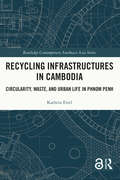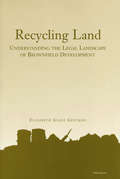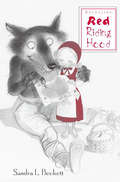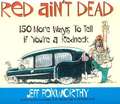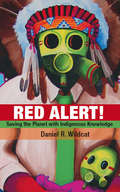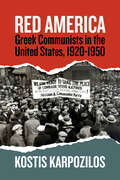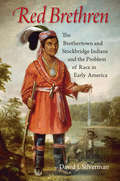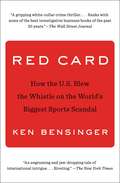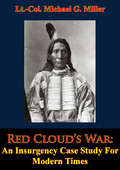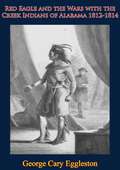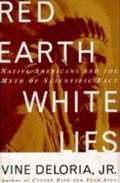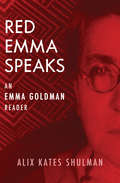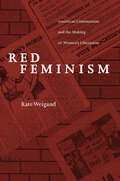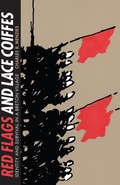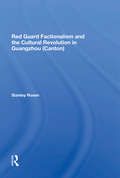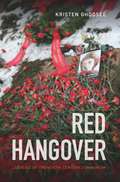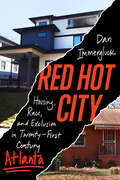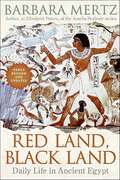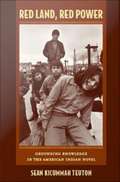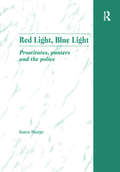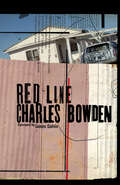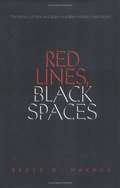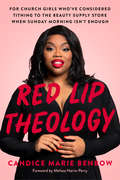- Table View
- List View
Recycling Infrastructures in Cambodia: Circularity, Waste, and Urban Life in Phnom Penh (Routledge Contemporary Southeast Asia Series)
by Kathrin EitelThis book examines the recycling infrastructure in Phnom Penh, Cambodia. It considers the circular flows of waste and practices through ‘infracycles’, maintenance practices that tinker with the social and capitalist order, and postcolonial ways of doing politics that co-constitute predominant waste fantasies from which naturecultures ooze out, shaping urban life in their own way. In this context, socially marginalized waste pickers contest the capitalist system by creating tropes about freedom, labor autonomy, and the will to survive. In this regard, they are also meddling about a new social order that represents the fine line Cambodia is sashaying between tradition and modernity. Waste fantasies that are a result of environmental problematizations, however, perpetuate postcolonial ways of doing politics by exuding notions of waste as detached from its sociocultural context. But ultimately, waste slips through the cracks of these dominant imaginaries and global waste reduction models enacting new versions of what waste and the city is, providing opportunities for another future waste policy. This book is a unique contribution to the field of infrastructure studies emphasizing the importance of perceiving infrastructure as circular in smaller ‘infracycles’, rather than linear. It will be of interest to researchers in the field of environmental anthropology, science and technology studies, urban studies, and Southeast Asian studies. The Introduction of this book is available for free in PDF format as Open Access from the individual product page at www.routledge.com. It has been made available under a Creative Commons Attribution-Non Commercial-No Derivatives 4.0 license
Recycling Land: Understanding the Legal Landscape of Brownfield Development
by Elizabeth Glass GeltmanOlder--and often economically depressed--industrial cities generally have a number of well located but abandoned industrial sites. Too frequently these sites are heavily polluted by the residue of toxic wastes dumped when old factories were still in use. These "brownfield" sites must be cleaned up under existing law before they can be redeveloped. And yet the question of who will bear the cost of this cleanup frequently stymies efforts to return these sites to productive use. A complicated net of federal, state and local regulations can involve several generations of owners in potential liability for the cleanup, frequently resulting only in extended litigation, not often in the cleanup of the site. In this book, Elizabeth Glass Geltman surveys the laws on both the federal and state level with regard to the cleanup of brownfield sites. The author makes valuable suggestions for reforming these laws that will help encourage land reuse and the accompanying redevelopment of the industrial base of many American cities both large and small. Elizabeth Glass Geltman is Professor of Law, George Washington University Law School and is the author of many books on environmental law, includingModern Environmental Law: Policy and Practice.
Recycling Red Riding Hood (Children's Literature and Culture #Vol. 23)
by Sandra BeckettSandra Beckett's book explores the contemporary retelling of the Red Riding Hood tale in Western children's literature.
Red Ain't Dead: 150 More Ways To Tell If You're A Redneck
by Jeff FoxworthyIt is true, as you may have heard, that a comedian's jokes are like his children. You conceive them (not nearly as much fun as with real kids), nurture them, and eventually let them go. Like real children, some are cute, some are bad, and once in a while one exceeds every expectation you ever had for it. That was the case with my "Redneck" jokes. Appropriately conceived in a cheap motel in Huntsville, Alabama, they quickly grew into more than a comedy bit or even a best-selling book. They became a part of my life. People stop me in airports or on streets and say, "Hey, you're the Redneck guy! And I'm one of 'em!" Excerpts from the first book, YOU MIGHT BE A REDNECK IF..., have been copied, modified, and faxed from workplace to workplace. The material has been "borrowed" by newspapers, wire services, and radio stations nationwide. I feared we had beaten the subject to death, but not a day goes by that someone doesn't offer me a new example of "redneckism." I have received photos of front-yard flower pots made out of old toilets, and newspaper clippings of grooms wearing Harley-Davidson tee-shirts. With the help of my wife and friends, I add several to the list almost daily. I have collected numerous Redneck lines from radio audiences and even from my live show audiences. I must admit that I am very proud of my "Redneck child." I am even happier that others love it as I do. So for all those people, here is a second helping. Though conventional wisdom says you can't believe everything you read, in this case I assure you that you can. Red ain't dead. - Jeff Foxworthy
Red Alert!
by Daniel R. Wildcat"Red Alert! offers insight, hope, and a path forward."--Billy Frank Jr., Chairman, Northwest Indian Fisheries Commission"What the world needs today is a good dose of indigenous realism," says Native American scholar Daniel R. Wildcat in this thoughtful, forward-looking treatise. The Native response to the environmental crisis facing our planet, Red Alert! seeks to debunk our civilization's long-misguided perception that humankind is at odds with nature or that it exerts control over the natural world.Taking a hard look at the biggest problem that we face today--the damaging way we live on this earth--Wildcat draws upon ancient Native American wisdom and nature-centered beliefs to advocate a modern strategy to combat global warming. Inspiring and insightful, Red Alert! is a stirring call to action.Daniel R. Wildcat (Yuchi, Muscogee) is the director of the American Indian studies program and the Haskell Environmental Research Studies Center at Haskell Indian Nations University in Lawrence, Kansas. He is the co-author with Vine Deloria Jr. of Power and Place: Indian Education in America and the co-author of Destroying Dogma: Vine Deloria Jr. and His Influence on American Society.
Red America: Greek Communists in the United States, 1920-1950
by Kostis KarpozilosHistorians of immigration and ethnicity in the United States have typically devoted little attention to Greek Americans, while popular narratives depict them as indifferent or hostile to political and social radicalism. From acclaimed historian Kostis Karpozilos, Red America provides an alternative narrative of the Greek American experience. Focusing on the history of the Greek American Left from the beginning of the twentieth century to the Cold War, this volume uncovers the threads that bound notions of radical social change to everyday immigrant life, tracing ethnic radicalism from the boundaries of a specific community to the epicenter of American social and political history.
Red Brethren: The Brothertown and Stockbridge Indians and the Problem of Race in Early America
by David J. SilvermanNew England Indians created the multitribal Brothertown and Stockbridge communities during the eighteenth century with the intent of using Christianity and civilized reforms to cope with white expansion. In Red Brethren, David J. Silverman considers the stories of these communities and argues that Indians in early America were racial thinkers in their own right and that indigenous people rallied together as Indians not only in the context of violent resistance but also in campaigns to adjust peacefully to white dominion. All too often, the Indians discovered that their many concessions to white demands earned them no relief. In the era of the American Revolution, the pressure of white settlements forced the Brothertowns and Stockbridges from New England to Oneida country in upstate New York. During the early nineteenth century, whites forced these Indians from Oneida country, too, until they finally wound up in Wisconsin. Tired of moving, in the 1830s and 1840s, the Brothertowns and Stockbridges became some of the first Indians to accept U.S. citizenship, which they called "becoming white," in the hope that this status would enable them to remain as Indians in Wisconsin. Even then, whites would not leave them alone. Red Brethren traces the evolution of Indian ideas about race under this relentless pressure. In the early seventeenth century, indigenous people did not conceive of themselves as Indian. They sharpened their sense of Indian identity as they realized that Christianity would not bridge their many differences with whites, and as they fought to keep blacks out of their communities. The stories of Brothertown and Stockbridge shed light on the dynamism of Indians' own racial history and the place of Indians in the racial history of early America.
Red Card: How the U.S. Blew the Whistle on the World's Biggest Sports Scandal
by Ken BensingerThe definitive, shocking account of the FIFA scandal—the biggest international corruption case of recent years, spearheaded by US investigators, involving dozens of countries, and implicating nearly every aspect of the world’s most popular sport, soccer, including its biggest event, the World Cup.The FIFA case began small, boosted by an IRS agent’s review of an American soccer official’s tax returns. But that humble investigation eventually led to a huge worldwide corruption scandal that crossed continents and reached the highest levels of the soccer’s world governing body in Switzerland. In Red Card, Ken Bensinger explores the case, and the personalities behind it, in vivid detail. There’s Chuck Blazer, a high-living soccer dad who ascended to the highest ranks of the sport while creaming millions from its coffers; Jack Warner, a Trinidadian soccer official whose lust for power was matched only by his boundless greed; and the sport’s most powerful man, FIFA president Sepp Blatter, who held on to his position at any cost even as soccer rotted from the inside out. Remarkably, this corruption existed for decades before American law enforcement officials began to secretly dig, finally revealing that nearly every aspect of the planet’s favorite sport was corrupted by bribes, kickbacks, fraud, and money laundering. Not even the World Cup, the most-watched sporting event in history, was safe from the thick web of corruption, as powerful FIFA officials extracted their bribes at every turn. Arriving just in time for the 2018 World Cup, Red Card goes beyond the headlines to bring the real story to light, accompanying the determined American prosecutors and special agents who uncovered what proved to be not only the biggest scandal in sports history, but one of the biggest international corruption cases ever. And it is far from over.
Red Cloud’s War: An Insurgency Case Study For Modern Times
by Lt.-Col. Michael G. MillerThis will be a case study of the little known Fetterman Massacre of 1866. It will look the situation at the time, possible causes, key players, the massacre itself and the aftermath. Similarities to the counterinsurgency in Afghanistan will be noted where applicable throughout this paper. A case will be proposed that the Army was ill prepared for the Indian Wars of the latter 19th Century, just as they were initially ill prepared for an extended Afghanistan Insurgency Campaign. Connections are drawn showing that there were lessons learned in 1866 that are still appropriate today. Familiarity with them, along with other more recent examples, will better prepare the Army to fight counterinsurgencies in the future.
Red Eagle and the Wars with the Creek Indians of Alabama 1812-1814
by George Cary Eggleston“Red Sticks, White Sticks and the war in AlabamaThe Creek Indian War, also known as the Red Stick War, took place between 1813-1814 and has been considered by many historians as part of the War of 1812. The Creek—or Muscogee—Indians of Alabama were effectively waging a civil war among themselves. One militant faction, the so called Red Sticks, proposed an aggressive return to the traditional life of their forebears and an end to treaties with and concessions to pioneer settlers represented by the United States government. The White Sticks, opting for peace, inevitably took the opposing view. Although the conflict began as one between the indigenous Indians, American forces, under the soon to be famous Andrew Jackson among others, were drawn into the conflict because much of the animosity was focussed on pioneer settlements. The conflict started in the usual manner of American Indian Wars—with the murder of settler families. The inevitable revenge and retribution that followed—and an escalation of the kind of merciless savagery the Americans had come to expect—culminated in the massacre of 500 settlers, friendly Indians, mixed blood Creeks and soldiers at Fort Mims in an attack led by the Red Stick war leader, Red Eagle. Other forts were also attacked. Panic spread through the region exacerbated by the inability of the Federal government to provide ready aid since it was engaged against the British and their Indian allies to the east. As a consequence much of the fighting was undertaken by militias from Tennessee, Georgia and Mississippi supported by White Stick allies. National hero, Davy Crockett, also served in this conflict. The war ended in a victory for the Americans and put Andrew Jackson on a path to the presidency and the White House. It was a disaster for the entire Creek Indian tribe—irrespective of their allegiances—who paid for the conflict through the confiscation of vast tracts of their traditional lands.”-Print ed.
Red Earth, White Lies: Native Americans and the Myth of Scientific Fact
by Vine Deloria Jr.Deloria (history, law, religious studies, political science, U. of Colorado-Boulder), author of the best-selling "Custer Died For Your Sins", examines modern science as it relates to Native American oral history and exposes the myth of scientific fact, defending Indian accounts of natural history and population movement. He demonstrates how scientists manipulate data to fit their theories and documents traditional knowledge of Indian tribes in areas such as evolution, planetary history, the origin of humans, and natural disasters.
Red Emma Speaks: An Emma Goldman Reader (Contemporary Studies In Philosophy And The Human Sciences Ser.)
by Alix Kates ShulmanA comprehensive collection of writings and lectures by one of twentieth-century America&’s most important political activists, with two essays by editor Alix Kates Shulman, a leader of feminism&’s second waveEmma Goldman&’s fiery speeches and essays made her a household name in the early 1900s. Collected here are the most significant of her writings, supplemented with an essay on Goldman&’s feminist politics and a short biography, both by bestselling author Alix Kates Shulman. Including both published and previously unpublished works, Red Emma Speaks is an important historical volume and a fascinating look at the life and times of a major early feminist figure.
Red Feminism: American Communism and the Making of Women's Liberation (Reconfiguring American Political History)
by Kate WeigandDrawing on substantial new research, Red Feminism traces the development of a distinctive Communist strain of American feminism from its troubled beginnings in the 1930s, through its rapid growth in the Congress of American Women during the early years of the Cold War, to its culmination in Communist Party circles of the late 1940s and early 1950s. The author argues persuasively that, despite the devastating effects of anti-Communism and Stalinism on the progressive Left of the 1950s, Communist feminists such as Susan B. Anthony II, Betty Millard, and Eleanor Flexner managed to sustain many important elements of their work into the 1960s, when a new generation took up their cause and built an effective movement for women's liberation. Red Feminism provides a more complex view of the history of the modern women's movement, showing how key Communist activists came to understand gender, sexism, and race as central components of culture, economics, and politics in American society.
Red Feminism: American Communism and the Making of Women's Liberation (Reconfiguring American Political History)
by Kate WeigandThe untold history of feminist activism in the American Communist Party from the 1930s–50s and its influence on the women&’s liberation movement (Publishers Weekly). Drawing on substantial new research, historian and archivist Kate Weigand disproved the conventional wisdom that the American Communist Party disregarded women&’s issues. Weigand argues that, despite the devastating effects of anti-Communism and Stalinism on the progressive Left of the 1950s, Communist feminists such as Susan B. Anthony II, Betty Millard, and Eleanor Flexner managed to sustain many important elements of their work into the 1960s, when a new generation took up their cause and built an effective movement for women&’s liberation. Red Feminism provides a more complex view of the history of the modern women&’s movement, showing how key Communist activists came to understand gender, sexism, and race as central components of culture, economics, and politics in American society.
Red Flags and Lace Coiffes: Identity And Survival In A Breton Village
by Charles R. MenziesThis book explores the question of why fishing communities continue their struggle to survive, despite often calamitous changes in ecology and economy. Using historical ethnography as a lens through which to understand how fishers of the Bigouden region of France and their families have reinvented themselves, Menzies argues that local identity plays an important role in their perseverance as global capitalist pressures continually force them to reorganize or disappear entirely. Touching on many concepts that are fundamental to anthropology—culture, identity, kinship, work, political economy, and globalization—and filled with personal stories and warmth, this ethnography will be a welcome teaching tool for instructors and an enticing read for students.
Red Guard Factionalism And The Cultural Revolution In Guangzhou (canton)
by Stanley RosenWhen the Chinese Great Proletarian Cultural Revolution (GPCR) of the middle and late 1960s burst forth, the initial response both in China and the West seemed primarily to be one of mystification. The spectacle of severe splits among leaders long thought to be compatible, of armed struggles between factional units whose uniform pledges to Chairman Mao and the Party Center appeared to make their similarities greater than their differences, and of destructive Red Guards who were bent on "tearing down the old world to build a new one" was at first difficult to explain.
Red Hangover: Legacies of Twentieth-Century Communism
by Kristen GhodseeIn Red Hangover Kristen Ghodsee examines the legacies of twentieth-century communism twenty-five years after the Berlin Wall fell. Ghodsee's essays and short stories reflect on the lived experience of postsocialism and how many ordinary men and women across Eastern Europe suffered from the massive social and economic upheavals in their lives after 1989. Ghodsee shows how recent major crises—from the Russian annexation of Crimea and the Syrian Civil War to the rise of Islamic State and the influx of migrants in Europe—are linked to mistakes made after the collapse of the Eastern Bloc when fantasies about the triumph of free markets and liberal democracy blinded Western leaders to the human costs of "regime change." Just as the communist ideal has become permanently tainted by its association with the worst excesses of twentieth-century Eastern European regimes, today the democratic ideal is increasingly sullied by its links to the ravages of neoliberalism. An accessible introduction to the history of European state socialism and postcommunism, Red Hangover reveals how the events of 1989 continue to shape the world today.
Red Hot City: Housing, Race, and Exclusion in Twenty-First-Century Atlanta
by Dan ImmergluckAn incisive examination of how growth-at-all-costs planning and policy have exacerbated inequality and racial division in Atlanta. Atlanta, the capital of the American South, is at the red-hot core of expansion, inequality, and political relevance. In recent decades, central Atlanta has experienced heavily racialized gentrification while the suburbs have become more diverse, with many affluent suburbs trying to push back against this diversity. Exploring the city’s past and future, Red Hot City tracks these racial and economic shifts and the politics and policies that produced them. Dan Immergluck documents the trends that are inverting Atlanta’s late-twentieth-century "poor-in-the-core" urban model. New emphasis on capital-driven growth has excluded low-income people and families of color from the city’s center, pushing them to distant suburbs far from mass transit, large public hospitals, and other essential services. Revealing critical lessons for leaders, activists, and residents in cities around the world, Immergluck considers how planners and policymakers can reverse recent trends to create more socially equitable cities.
Red Land, Black Land: Daily Life in Ancient Egypt
by Barbara MertzA fascinating, erudite, and witty glimpse of the human side of ancient Egypt—this acclaimed classic work is now revised and updated for a new generationDisplaying the unparalleled descriptive power, unerring eye for fascinating detail, keen insight, and trenchant wit that have made the novels she writes (as Elizabeth Peters and Barbara Michaels) perennial New York Times bestsellers, internationally renowned Egyptologist Barbara Mertz brings a long-buried civilization to vivid life. In Red Land, Black Land, she transports us back thousands of years and immerses us in the sights, aromas, and sounds of day-to-day living in the legendary desert realm that was ancient Egypt.Who were these people whose civilization has inspired myriad films, books, artwork, myths, and dreams, and who built astonishing monuments that still stagger the imagination five thousand years later? What did average Egyptians eat, drink, wear, gossip about, and aspire to? What were their amusements, their beliefs, their attitudes concerning religion, childrearing, nudity, premarital sex? Mertz ushers us into their homes, workplaces, temples, and palaces to give us an intimate view of the everyday worlds of the royal and commoner alike. We observe priests and painters, scribes and pyramid builders, slaves, housewives, and queens—and receive fascinating tips on how to perform tasks essential to ancient Egyptian living, from mummification to making papyrus.An eye-opening and endlessly entertaining companion volume to Temples, Tombs, and Hieroglyphs, Mertz's extraordinary history of ancient Egypt, Red Land, Black Land offers readers a brilliant display of rich description and fascinating edification. It brings us closer than ever before to the people of a great lost culture that was so different from—yet so surprisingly similar to—our own.
Red Land, Red Power: Grounding Knowledge In the American Indian Novel
by Sean Kicummah TeutonIn lucid narrative prose, Sean Kicummah Teuton studies the stirring literature of "Red Power," an era of Native American organizing that began in 1969 and expanded into the 1970s. Teuton challenges the claim that Red Power thinking relied on romantic longings for a pure Indigenous past and culture. He shows instead that the movement engaged historical memory and oral tradition to produce more enabling knowledge of American Indian lives and possibilities. Looking to the era's moments and literature, he develops an alternative, "tribal realist" critical perspective to allow for more nuanced analyses of Native writing. In this approach, "knowledge" is not the unattainable product of disinterested observation. Rather it is the achievement of communally mediated, self-reflexive work openly engaged with the world, and as such it is revisable. For this tribal realist position, Teuton enlarges the concepts of Indigenous identity and tribal experience as intertwined sources of insight into a shared world. While engaging a wide spectrum of Native American writing, Teuton focuses on three of the most canonized and, he contends, most misread novels of the era--N. Scott Momaday's House Made of Dawn (1968), James Welch's Winter in the Blood (1974), and Leslie Marmon Silko's Ceremony (1977). Through his readings, he demonstrates the utility of tribal realism as an interpretive framework to explain social transformations in Indian Country during the Red Power era and today. Such transformations, Teuton maintains, were forged through a process of political awakening that grew from Indians' rethought experience with tribal lands and oral traditions, the body and imprisonment, in literature and in life.
Red Light, Blue Light: Prostitutes, Punters and the Police
by Karen SharpeBased on extensive interviews with forty women working as prostitutes, Red Light, Blue Light examines a variety of personal developmental experiences and socio-situational factors that can combine to make prostitution neither an inevitable nor inescapable circumstance but a rational occupational choice. This book attempts to analyze why women enter the world of prostitution, how the skills and values of the business are transmitted and how the individuals themselves subjectively define, perceive and rationalise their activity. As opposed to the traditional stereotypical depiction of prostitutes as hopeless, downtrodden victims of male exploitation living lives of poverty, misery and wretchedness, the picture that emerges in this study is of an independent occupational group organizing and controlling the business in which they work. The book also presents a profile of clients of prostitutes and discusses the role of the police. Written in accessible style, the resulting monograph presents a fascinating, unique and comprehensive account of street prostitution in a northern city.
Red Lights: The Lives of Sex Workers in Postsocialist China
by Tiantian ZhengIn China today, sex work cannot be untangled from the phenomenon of rural-urban migration, the entertainment industry, and state power. In Red Lights, Tiantian Zheng highlights the urban karaoke bar as the locus at which these three factors intersect and provides a rich account of the lives of karaoke hostesses—a career whose name disguises the sex work and minimizes the surprising influence these women often have as power brokers. Zheng embarked on two years of intensely embedded ethnographic fieldwork in her birthplace, Dalian, a large northeastern Chinese seaport of over six million people. During this time, Zheng lived and worked with a group of hostesses in a karaoke bar, facing many of the same dangers that they did and forming strong, intimate bonds with them. The result is an especially engaging, moving story of young, rural women struggling to find meaning, develop a modern and autonomous identity, and, ultimately, survive within an oppressively patriarchal state system. Moving from her case studies to broader theories of sex, gender, and power, Zheng connects a growth in capitalist entrepreneurialism to the emergence of an urban sex industry, brilliantly illuminating the ways in which hostesses, their clients, and the state are mutually created in postsocialist China.
Red Line
by Charles BowdenThe author is joined by a retired narcotics cop as they investigate the assassination of a drug dealer and hit man outside Tucson, Arizona.One of Charles Bowden&’s earliest books, Red Line powerfully conveys a desert civilization careening over the edge―and decaying at its center. Bowden&’s quest for the literal and figurative truth behind the assassination of a murderous border-town drug dealer becomes a meditation on the glories of the desert landscape, the squalors of the society that threatens it, and the contradictions inherent in trying to save it.&“At its best, Red Line can read like an original synthesis of Peter Matthiessen and William Burroughs . . . A brave and interesting book.&” —David Rieff, Los Angeles Times Book Review&“Charles Bowden&’s Red Line is a look at America through the window of the southwest. His vision is as nasty, peculiar, brutal, as it is intriguing and, perhaps, accurate. Bowden offers consciousness rather than consolation, but in order to do anything about our nightmares we must take a cold look and Red Line casts the coldest eye in recent memory.&” —Jim Harrison&“The Southwest as portrayed in this Kerouac-esque odyssey betokening the death of the American frontier spirit is a landscape of broken dreams, violence, uprooted lives and fallen idols. . . . Miles distant from tourist-poster images of the Sunbelt, this vista of narrow greed, diminished expectations and despoilation of nature sizzles with the harsh, unrelenting glare of a hyperrealist painting.&” —Publishers Weekly
Red Lines, Black Spaces: The Politics of Race and Space in a Black Middle-class Suburb
by Bruce D. HaynesRed Lines, Black Spaces is a case study of Nepperhan-Runyon Heights, one of the first middle-class black suburbs in the New York metropolitan region. Runyon Heights is nestled in the northeast section of Yonkers, New York, on the banks of the Hudson River, in the southwest corner of Westchester County, just north of New York City.
Red Lip Theology: For Church Girls Who've Considered Tithing to the Beauty Supply Store When Sunday Morning Isn't Enough
by Candice Marie BenbowA moving essay collection promoting freedom, self-love, and divine wholeness for Black women and opening new levels of understanding and ideological transformation for non-Black women and allies&“Candice Marie Benbow is a once-in-a-generation theologian, the kind who, having ground dogma into dust with the fine point of a stiletto, leads us into the wide-open spaces of faith.&”—Brittney Cooper, author of Eloquent Rage and co-editor of The Crunk Feminist Collection Blurring the boundaries of righteous and irreverent, Red Lip Theology invites us to discover freedom in a progressive Christian faith that incorporates activism, feminism, and radical authenticity. Essayist and theologian Candice Marie Benbow&’s essays explore universal themes like heartache, loss, forgiveness, and sexuality, and she unflinchingly empowers women who struggle with feeling loved and nurtured by church culture. Benbow writes powerfully about experiences at the heart of her Black womanhood. In honoring her single mother&’s love and triumphs—and mourning her unexpected passing—she finds herself forced to shed restrictions she&’d been taught to place on her faith practice. And by embracing alternative spirituality and womanist theology, and confronting staid attitudes on body positivity and LGBTQ+ rights, Benbow challenges religious institutions, faith leaders, and communities to reimagine how faith can be a tool of liberation and transformation for women and girls.
